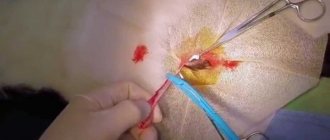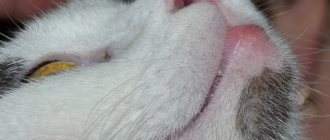Symptoms and treatment of throat diseases in cats
Medical otolaryngologists are still sometimes called "ear, nose and throat" doctors. Following this tradition, a number of visitors to our forum ask to talk about the treatment of “throat diseases” of cats,” apparently implying tonsillitis, inflammation, swelling, spasm and stenosis of the larynx.
In case of acute inflammation of the tonsils (tonsillitis), animals' body temperature rises, depression, lethargy, drooling, and difficulty swallowing appear, which causes a deterioration in appetite or refusal to feed. A cough appears - at first it is dry, then in most cases it is wet (productive). The voice changes (becomes hoarse, abrupt). In the upper part of the neck (in the submandibular spaces), enlarged lymph nodes are palpated; when pressed, the animal exhibits a painful reaction. The tonsils turn red, increase in size, and may partially block the lumen of the pharyngeal ring.
Depending on the nature and stage of the inflammatory process, the tonsils may be covered with clear or whitish mucus and pus; abscesses and erosions (small ulcers) may appear on them. Chronic tonsillitis is characterized by long-term manifestation (weeks and months) of the same symptoms, which are much less pronounced than in the acute course.
Inflammation of the larynx ( laryngitis ) is manifested by a cough (initially dry, and later it is accompanied by the discharge of sputum), changes in meowing (hoarseness, loss of voice, etc.), difficulty swallowing and taking water, a variable increase in body temperature and depression. The duration of the disease usually does not exceed 7-10 days. Under unfavorable conditions, it can develop into a subacute or chronic form. They are accompanied by the same, but less pronounced clinical signs as acute laryngitis, which persist for several weeks and even over a month. Chronic laryngitis may worsen.
Laryngospasm is manifested by periodically occurring attacks of convulsive closure of the glottis with prolonged noisy inhalation, bluing of the mucous membranes, twitching of the limbs, coughing, constriction of the pupils, sometimes with cessation of breathing and loss of consciousness. The attack usually lasts a few seconds and breathing is restored.
Clinical manifestations of laryngeal edema depend on the location and severity of the lesions. They may be limited by difficulty swallowing or cause shortness of breath. In this case, significant stenosis (narrowing) of the lumen of the larynx often occurs.
Laryngeal stenosis passes through stage 3 in its pathogenesis. In the first of them, the pause between inhalation and exhalation disappears, inhalation lengthens, breathing frequency decreases, meowing becomes hoarse, and during inhalation a stenotic noise appears, audible at a considerable distance. At the second stage, signs of oxygen starvation appear, shortness of breath intensifies, the skin and visible mucous membranes take on a bluish tint, and when inhaling, the intercostal spaces sharply retract. Cats show restlessness and unreasonable motor activity, their breathing becomes more frequent, which is accompanied by breathing noises. At the third stage, suffocation appears, in which breathing becomes rare and shallow, cardiac activity weakens, pallor increases and the skin becomes bluish, cats become lethargic, do not show interest in current events, react poorly to external stimuli, and their pupils dilate. Ultimately, breathing stops, loss of consciousness, and involuntary excrement occur.
In cats, these syndromes rarely manifest themselves. However, for ease of understanding the principles of their treatment, we will conditionally assume that these are independent diseases.
They have many things in common, including approaches to treatment. First of all, a sick cat is placed in a quiet, calm, warm place where there is no draft. We should not forget about diet therapy: if you manage to establish normal feeding for the animal, it will recover faster. Since inflammatory processes in this part of the respiratory system make it difficult to swallow, during the period of illness the animal is given crushed, semi-liquid, high-calorie food (preferably made from the foods that the cat loved before the illness).
For tonsillitis , local treatments are carried out - practically the same as those used by people suffering from the same illness (adjusted for the character of the cat, on which the possibility of using certain medications largely depends): lubricating the tonsils with solutions of Lugol, iodinol, furatsilin, protargol, the use of aerosols with propolis or antimicrobial drugs, irrigation with solutions of furatsilin or potassium permanganate.
If an animal is diagnosed with a viral infection (rinotracheitis, calicivirus, etc.), then a course of treatment is carried out, which we recommended on the forum when discussing the treatment of these diseases. The cough can be relieved with the medication bromhexine (preferably a suspension for children). Persistent elevated temperature is reduced with antipyretic drugs (injections or rectal administration of analgin solution and other drugs). In severe cases of the disease, anti-inflammatory drugs and injectable antibiotics are used. In the absence of purulent deposits on the tonsils, warm compresses on the neck are recommended. The ineffectiveness of drug therapy is an indication for surgical removal of the tonsils (tonsillectomy).
For laryngitis , the causes that caused it are eliminated (infections, foreign bodies, etc.), physiotherapeutic procedures are carried out (warming compresses, heating with infrared/ultraviolet light, etc.), inhalation of essential oils, treatment with aerosols with antimicrobial drugs, irrigating the throat of cats with decoctions of chamomile, St. John's wort , string, thyme and other herbs that have an anti-inflammatory effect, lubricating the tonsils and larynx with Lugol's solution.
During a spasm of the larynx, restoration of the lumen of the organ is initiated by irritating the mucous membrane of the animal’s oral and nasal cavities (massage, exposure to ammonia vapor or essential oils), as well as the skin (spraying with cold water, pinching, pricking). In severe cases, emergency qualified assistance from a veterinary specialist (intubation or tracheostomy) is required. After the end of the attack, the cat is examined to identify the causes of bronchospasm (for example, detection and removal of a foreign body from the larynx). Animals prone to bronchospasm are kept in a well-ventilated area, and the use of chemicals and other odorous substances in their presence is avoided.
If there is swelling of the larynx, it is recommended to immediately contact a veterinary clinic, as it can lead to laryngeal stenosis and death due to suffocation. As temporary measures, gauze soaked in a bowl of water and ice is applied to the neck, corticosteroid aerosols are used, and diuretics are given. If stenosis develops, tracheostomy and tracheal intubation are necessary to save the cat's life.
Laryngeal stenosis is extremely dangerous and requires intensive treatment. If it develops gradually (over several days), then there is a chance to stop the pathological process by using anti-inflammatory, antimicrobial, diuretic and cardiac drugs. In severe cases, as noted above, the cat's life is saved by tracheostomy or intubation. After the animal is brought out of a critical condition, the cause of the syndrome is established and efforts are made to eliminate it (the foreign body is removed, the tumor is removed, scar tissue is excised, etc.).
Common causes of voice loss in cats
The nightly serenades of March singers until you become hoarse are not the only explanation for your pet’s hoarse and quiet voice. All reasons can be divided into three groups:
1. Mechanical damage, small objects getting into the cat’s throat.
Kittens suffer more often: while playing, they can swallow small, sharp objects. The owner entertains the pet with a toy tied to a string. The kitten, having caught up with the rustling foil bow, begins to chew it. A sharp piece of metallized paper gets into the throat and gets stuck. And how many interesting but dangerous games take place without human control! Adult cats suffer from damage from bones in poultry and fish meat (small elastic bones, scales in river fish). Curious animals explore new objects, often tasting pine needles and Christmas tree decorations. On New Year's weekend, queues line up to see veterinarians due to injuries to the larynx and pharynx in cats. The owners were concerned about the disappearance of their pets' voices.
2. Chemical poisoning, dehydration.
Cats avoid objects with a sharp, pungent odor. Of course, no animal will taste spilled gasoline or paint products. For cats to become poisoned, it is enough to inhale toxic fumes. People often do not notice that using air freshener or nail polish remover has a depressing effect on the cat. Repeated or prolonged inhalation of chemicals leads to poisoning. The cat wheezes, sneezes, refuses to eat, and loses its voice.
Veterinarians give specific examples. The cat “accompanied” its owner in the hallway every morning. She, having made the final touch, fixed her hair with hairspray, and ran off to work. This went on for several weeks. Another visit to the doctor: the cat experienced loss of voice, nausea and wheezing. The veterinarian, having examined the animal, immediately determined the cause of the disease - smoking in the room, poor ventilation, low air humidity. This was “told” by the smell of cigarette smoke from the fur and changes in the cat’s vocal cords.
Cats walking unattended can end up in a landfill or construction site where there is a lot of chemical waste. Don't ignore your pet's loss of voice if you don't know what happened. The danger to the animal is a reality.
Lethargy, lack of playfulness, and an unnatural hoarse sound are some signs of dehydration. Milk, kefir, broth, and any food will not replace clean water. It should be in the cup all the time.
3. Infectious diseases.
Cats also suffer from infectious diseases. They have sore throat, otitis media, colds and other infections that are transmitted through the air. The infection cannot affect the host. Some people do not let their cats outside because they are confident in their safety. This is not an option. Drafts, low temperature in the apartment, dampness, and poor nutrition weaken the immune system and will not improve the health of cats.
How to diagnose the disease? Loss of voice indicates advanced disease. You missed the beginning: the cat sleeps a lot, has a dry nose, watery eyes, and poor appetite. Only a veterinarian will associate the lack of voice with damage to the respiratory system and rhinotracheitis. Or the cause of silent meowing is laryngitis, the mucous membranes of the throat are inflamed, swelling of the larynx is observed, and the vocal cords are clogged with mucus.
Basic information, predisposing factors
As you know, edema is the pathological process of fluid accumulation in cells and intercellular space. As a result, the affected organ swells, and in most cases its functionality deteriorates sharply. In general, the same can be said about laryngeal edema.
In severe cases, it swells so much that it completely blocks the flow of air, which can even lead to the death of the animal from suffocation. However, even in relatively simple situations there is little pleasure from this pathology, since the cat cannot eat or drink. In addition, the pet may be very nervous (which is not surprising), and stress only leads to aggravation of the process. By the way, what are the causes of this pathology? There can be quite a lot of them, but we will give the main list:
- Allergy. Perhaps the most common and insidious reason. It occurs suddenly, quickly, and is often fatal, since the swelling in this case may well completely block the entire windpipe.
- Poisoning, including from drugs or household chemicals. It often occurs in conjunction with an allergic reaction, and therefore leads to even more serious consequences.
- Autoimmune pathology. In general, this also includes cases of idiopathy: this is when the true root cause of the disease cannot be established.
In rare cases, swelling of the larynx can be caused by some kind of mechanical injury to the throat, but this really happens infrequently. So, we figured out the reasons. How can you even understand that this particular trouble has happened to your pet? What are the symptoms of laryngeal edema in a cat?
What are the consequences?
If symptoms are not identified promptly and treatment is not started, feline laryngitis is dangerous with the following consequences:
An advanced disease in a pet can develop into bronchopneumonia.
- Swelling of the larynx. The condition threatens the life of the animal, as death from suffocation can occur.
- Sore throat in cats. Occurs when pathogenic microflora spreads to the tonsils. The disease is dangerous due to the development of infectious myocarditis.
- Laryngotracheitis and bronchopneumonia. Complications occur when the inflammatory process spreads to the lower respiratory tract. Leads to oxygen starvation or death.
- Abscess. Characterized by the formation of a cavity filled with pus. Promotes the development of phlegmon or sepsis, which leads to the death of the animal.
Symptoms
In veterinary practice, we most often observe those that develop most suddenly (in the case of an allergic reaction). The animal suddenly becomes ill, the cat breathes heavily and wheezes, and screams in a voice that is not its own. In milder cases, the cat “simply” cannot drink or eat, and wheezes or “grunts” hoarsely and with whistling sounds.
It should be noted that owners of Persian cats and animals of similar breeds, even in this case, rarely begin to sound the alarm and you should not blame them for “callousness”. The fact is that these representatives of the cat tribe initially have difficulty breathing due to the special structure of the nasal cavities.
Anaphylactic shock is especially insidious. Roughly speaking, this is a type of allergic reaction. At the same time, the larynx swells so quickly and so much that the owners do not always have time to take the cat to the veterinary clinic... Thus, if your pet suddenly begins to wheeze, sniffle, behave inappropriately and suffocate, immediately go to the veterinarian.
So how to treat laryngeal edema in a cat? It all depends on the root cause that caused it. Since it is often an allergy, the cat is immediately given lethal doses of antihistamines. But what if he simply may not survive until the drugs take effect, having “safely” suffocated? In this case, intubation cannot be avoided. Since swelling sometimes cannot be relieved for quite a long time, your pet will have to “show off” with a plastic tube in its throat for a couple of days.
He will not experience any particular inconveniences... but you will feel them to the fullest, since you will have to feed the animal by pouring nutritional compounds into its throat. However, this is fraught with many unpleasant consequences, including aspiration of the lungs, and therefore it is better to take the animal to the veterinarian: he will not only assess its condition, but also intravenously administer a glucose solution or another mixture that will support the cat.
Alas, drug treatment may not help if swelling and destructive lesions of the larynx have developed as a result of some kind of autoimmune pathology. It is possible that you will have to undergo a rather complex operation aimed at restoring the functionality of the organ.
What to do if you notice swelling in your cat?
In any case, it is worth showing the animal to a veterinarian as soon as possible. Edema can develop rapidly, within a few minutes, and threaten the life of the animal. Your first aid in this case can significantly alleviate the cat’s condition and improve the prognosis.
- If your swelling is hot and red, you can try applying cold and go to an appointment;
- If there is swelling of the muzzle or lips, try to give the animal an antihistamine (if you have one at home) and go to a veterinary clinic in Krasnoyarsk as soon as possible. It is better to clarify the dosage of the drug by calling our clinic +7(391)2-179-779;
- If you see your cat's breathing deteriorating due to swelling in the face or any other part of the body, try to provide air flow. See your doctor as soon as possible. If breathing stops, it is necessary to perform artificial respiration through a napkin, carefully opening your mouth with it.
At the clinic, the doctor will urgently examine the animal and provide symptomatic therapy aimed at stabilizing the condition, and then conduct additional diagnostics to make a diagnosis.
Tumor in the throat of cats
If laryngeal edema appears in a cat, this may be a complication of neoplasms such as laryngeal lymphosarcoma, squamous or poorly differentiated cancer, papilloma, or polyp. General symptoms of pathologies manifest themselves in the form of difficulty swallowing and breathing, enlarged lymph nodes, and cough. If your pet's health worsens, you should contact a veterinarian who will prescribe adequate treatment.
Based on personal practice, veterinary oncologist M. Yakunina believes that one of the causes of lymphosarcoma in cats is the leukemia virus (LVV), which is diagnosed in 40% of animals.
Types and symptoms: what are the pathologies?
Lymphosarcoma
The tumor is a malignant tumor and affects the lymph nodes. Due to the influence of unfavorable factors, a pathological accumulation of lymphocytes occurs, which become the cause of oncology. May spread to bone marrow. The disease develops against the background of long-term chronic illnesses, decreased immunity, and the animal staying in areas with increased radioactive radiation. Symptoms:
- difficulty breathing;
- enlarged lymph nodes;
- exhaustion due to intoxication and deterioration of swallowing function;
- stool instability;
- depressed state.
Return to contents
Squamous cell carcinoma of the throat
Develops in the oral cavity from flat cells of the mucosal epithelium. The neoplasm forms on the tongue or palate and can invade the tonsils, metastasizing to the structures of the throat. The cause is chronic inflammation of the larynx, untreated stomatitis, as well as licking of toxic components of antiparasitic agents from the fur. Signs:
- the appearance of erosions and ulcers in the throat;
- suppuration;
- strong bad breath;
- profuse drooling;
- nasal discharge if the cancer has spread to the upper jaw or nasopharynx;
- loss of appetite;
- stretching the neck forward when the animal is lying down;
- difficulty swallowing.
Return to contents
Poorly differentiated cancer
Most often it forms in the nasopharynx, from where it can spread to other tissues of the throat. The tumor can give extensive metastases to the brain, liver, lungs and has a rapid and aggressive course. Pathology occurs due to throat injuries, chronic respiratory infections, and weak immunity. Manifestation:
- lethargy, fatigue;
- noisy wheezing;
- dyspnea;
- problems with eating and swallowing;
- unkempt appearance;
- the appearance of lumps that can be felt through the skin;
- sudden weight loss.
What does cancer look like in cats?
Manifestations of cancer are as follows:
- "Bumps" on the animal's body. Of course, it's not necessarily cancer, but it's worth checking out. Because they don’t just appear, any lump on a cat’s body must have an explanation.
- Neoplasms. Wounds that do not heal for a long time, sometimes with purulent discharge from them.
- Unexplained discharge of pus from any part of the animal's body.
- Bad breath.
- Change in animal behavior towards weakness and drowsiness.
- Sudden loss of body weight.
- Intermittent claudication.
- Dyspeptic disorders.
- Spots on the skin are red or have dry scales.
- Refusal to eat or eats, but very little.
- Problems with the respiratory system, genitourinary, digestive.
How to treat tumors in the throat?
The treatment regimen is determined by the veterinarian individually based on the etiology of the tumor; self-medication can harm the animal. If the throat is swollen due to cancer, surgery is performed. Excision of the tumor is carried out, capturing healthy tissue. A tracheostomy tube is often required to facilitate the breathing process. If metastases are detected, chemotherapy is prescribed. Cytostatic drugs are used that prevent tumor development by destroying malignant cells. However, this method has many side effects. Drug treatment includes immunomodulatory agents, vitamin-mineral complexes, antibiotics (for suppuration). Papillomas can be treated with liquid nitrogen or laser.
What is laryngeal paralysis in cats and its causes?
Laryngeal paralysis in cats (LP) is a neurological disease that occurs due to impaired inspiratory abduction of the arytenoid cartilage due to dysfunction of the laryngeal muscles. Air in the required volume does not reach the lungs. Respiratory (breathing) function and gas exchange are disrupted, and oxygen starvation develops.
Important! The larynx is an organ of the respiratory system that performs protective, vocal, and respiratory functions in the body of animals. Conducts air into the trachea and bronchi, protects the lungs from food and vomit.
Causes of laryngeal paralysis in cats:
- Severe injuries to the spinal column, accompanied by spinal cord contusion. Most often they occur due to falls from heights and car accidents.
- Inflammation of the spinal cord that develops against the background of a viral, bacterial, or parasitic infection.
- Injuries, damage to the neck, sternum.
- Poisoning with potent poisons, toxins, chemicals, organophosphorus compounds, salts of heavy metals, chronic, acute intoxication.
- Age-related changes in the body.
- Neuromuscular diseases.
- Chronic nervous diseases, pathologies (peripheral neuropathy, vagus nerve dysfunction).
- Neoplasms benign, malignant.
- Birth defects.
- Myasthenia.
- Genetic, breed predisposition.
Important! Laryngeal paralysis in cats is one of the symptoms of such a deadly disease as rabies.
In cats, like other domestic animals, paralysis develops due to the collapse of the trachea. In this case, the pet requires urgent veterinary care. The count can go on for hours.
Neurological pathology is aggravated by endocrine problems (endocrinopathy), cardiovascular pathologies, diabetes, obesity, and other systemic disorders and illnesses.
With regards to breed and genetic predisposition, PG is diagnosed in representatives of Persian, Siamese breeds and their crossbreeds. Choking, neck injuries, unsuccessful operations in the neck and sternum can also lead to the development of this pathology in cats.
Treatment
How to cure allergic swelling of the throat? Therapy should be performed based on the origin of the disease. But, due to the complexity of diagnosing the disease, even with a detailed examination, treatment is performed according to one algorithm:
- The patient must be seated; a reclining position will do. Then he needs to be given intravenous diuretics. They quickly remove accumulated excess fluid in the body. This group of drugs includes Furosemide and Lasix.
- How to relieve swelling of the throat due to allergies? You definitely need to take an antihistamine. The patient is offered Zodak, Diazolin, Suprastin, Cetrizin, Zirtek, Tavegil.
- Antihypoxants and antioxidants are often prescribed. These are “Actovegin”, “Viksipin”, “Confumin”.
- The patient should be warm; mustard plasters can be placed on the calves. But you should not apply cold or hot compresses to your throat. In both cases there is a risk of worsening the condition.
- Treatment of throat swelling due to allergies is performed by inhalation with solutions of ephedrine, adrenaline, and hydrocortisone. The exact dosage must be determined by a doctor.
- If the problem arises from an infectious lesion, antibacterial therapy is needed. It includes drugs based on penicillin and streptomycin.
- In difficult situations, a tracheotomy is performed, which is performed only by an experienced doctor.
Treatment of throat swelling due to allergies in a child is performed in the same way as in adults. It is only important to consult a doctor before starting therapy. During the rehabilitation period, the underlying ailment must be treated. It is necessary to follow a diet in which only liquid and semi-liquid foods are consumed. Food should be at room temperature and should not include spices or vinegar dressings.
Types of laryngeal paralysis in cats
Types of laryngeal paralysis in cats are determined by etiology and the nature of the neurological pathology. Cats are diagnosed with congenital or acquired laryngeal paralysis, which, depending on the nature of its course, can be unilateral or bilateral.
Most paralysis in cats is idiopathic, meaning the cause of the neurological disease has not been fully established.
Idiopathic PG is detected by veterinarians in cats of older age groups.
About the treatment of cats with a neoplasm?
There are many treatment methods in veterinary medicine. The first thing the veterinarian recommends is to remove the tumor and send it to the laboratory for histological analysis. There, they will determine the type of neoplasm and tell you at what stage of development the disease is?
Now we need to decide whether to do chemotherapy? It is often prescribed for the late stages of tumors on the skin, mammary glands, or for those affecting tumors that for one reason or another cannot be excised. Sick cats are given strong tablets and intravenous drips. In some animals, when the tumor cannot be removed, radiation to the affected area is given.
Symptoms and first signs of paralysis in cats
Unilateral PG in cats can be asymptomatic for a long time. The first manifestations of pathology can be noticed only in old age.
Symptoms and manifestations of laryngeal paralysis in a cat:
- change in behavior;
- attacks of anxiety, panic;
- rapid fatigue after physical activity or exercise;
- loss of appetite, weight loss;
- gagging during or after eating;
- nasal discharge;
- pallor, cyanosis (cyanosis) of mucous membranes, tongue;
- respiratory dysfunction, noisy breathing;
- unstable temperature;
- change in voice timbre;
- violation of thermoregulation;
- salivation.
In cats with bilateral paralysis of the larynx, coughing attacks are observed, which intensify after activity, outdoor games, various types of shortness of breath, wheezing, vomiting, and fever. Eating food and water is difficult. During examination, the animals were noted to have impaired reflex functions of the spinal and cranial nerves, and local neuromuscular weakness.
Symptoms intensify after nervous overexcitation, stress, exertion, or in the heat. The course of the disease is excess weight, obesity, systemic and functional disorders in the body, unfavorable conditions of detention.
Diagnostic methods
If you notice problems with your pet's breathing, immediately take him to the veterinary clinic for an examination.
Diagnostic methods:
- Collection of anamnesis data.
- Full visual inspection.
- Serological studies (hormone analysis).
- ECHO.
- X-ray, chest X-ray.
- CT, MRI of the brain.
- Laryngoscopy.
- Auscultation.
- Electromyography.
If necessary, a number of additional tests and studies are carried out, differential diagnosis, since the symptoms of laryngeal paralysis are similar to many viral, bacterial, respiratory diseases, and the presence of a foreign body in the larynx.
Surgical methods of treatment
Treatment methods are prescribed by a veterinarian after diagnosis. The specialist takes into account the cat’s age, general condition, stage, and nature of the pathology. To alleviate the course of the disease, symptomatic therapy is used. Animals are prescribed diuretics, corticosteroids, sedatives, anti-inflammatory, decongestant medications, and homeopathic medications.
Additionally, treatment is carried out for concomitant diseases that were identified during the examination.
Oxygen therapy will help eliminate the symptoms of hypoxia. In emergency cases, temporary tracheotomy and tracheal intubation are performed to normalize respiratory function.
At the same time, the main method of treating PG in animals is surgery. Indicated for cats with pronounced, severe clinical symptoms and manifestations. The veterinarian can use both intralaryngeal and extralaryngeal methods of surgical treatment.
Important! Surgical treatment is aimed at increasing the lumen of the larynx, maintaining its normal shape, and normalizing respiratory function. The goal of laryngeal techniques is to restore impaired innervation.
Diagnostics and therapy
When visiting a veterinary hospital, the doctor prescribes a number of tests. First of all, the characteristics of the manifestation of the disease and the general condition of the cat are taken into account. To make an accurate diagnosis, laboratory and instrumental studies are carried out.
Endoscopy (specific examination of the larynx) is performed. The cat is given anesthesia and undergoes manipulation. If the cat is in critical condition, a decision is made to perform surgery. During the procedure, the specialist makes a hole and inserts a tube into the trachea, allowing the cat to breathe normally. Until the end of therapy, the tracheotome will be located in the animal's throat.
Relieving edema and reducing obstruction is achieved by introducing corticosteroid drugs into the patient's body. Diuretics are prescribed to speed up the process of removing excess fluid accumulated in the chest cavity, especially in the pulmonary structures. To reduce pain, the doctor prescribes non-steroidal anti-inflammatory drugs. This will allow the animal to eat again, increasing the chances of a successful recovery.
Possible complications and consequences
Despite the conservative and surgical treatment, one should not exclude possible complications and consequences, including:
- loss of voice function;
- food entering the larynx and other organs of the respiratory tract;
- cough, shortness of breath, whistling when breathing, residual noise;
- gagging after eating;
- seam divergence;
- hematomas;
- aspiration pneumonia.
Complications after surgical treatment are observed in 30-40% of animals. For example, after resection of the larynx, pneumonia is diagnosed in 35-45% of patients. It should not be ruled out that the death of the pet may occur due to serious complications. The final result is influenced by the age, general condition of the pet, conditions of care and maintenance, chronic, congenital pathologies of the nervous system.
Please note that after the operation, if the clinic provides a medical examination service, leave the cat for a day under the supervision of veterinarians.
Causes and risk factors
Among the causes of acute forms of laryngitis
note the following:
- ARVI;
- bacteria (staphylococcus, streptococcus);
- fungus (rarely, in patients with immunodeficiency);
- hypothermia (hypothermia);
- inhalation of chemicals;
- allergy;
- throat injuries;
- burn;
- ligament paralysis due to a stroke;
- GERD;
- pneumonia;
- tuberculosis;
- inflammation of the nasopharynx (rhinitis, etc.);
- dry air;
- metabolic disease;
- long course of antibiotics;
- stress.
Chronic laryngitis
due to:
- repeated laryngitis;
- constant load on the vocal apparatus (screaming, singing);
- frequent allergies;
- caries;
- pharyngitis;
- adenoiditis;
- prolonged sinusitis, bronchitis, tracheal pathology;
- long history of smoking (smoker's laryngitis), passive smoking;
- alcohol abuse.
If we talk about risk factors
, laryngitis is diagnosed more often in adults than in children. In addition, those at risk include those who:
- comes into contact with ARVI carriers;
- abuses alcoholic beverages and tobacco;
- is deficient in vitamins;
- has a weakened immune system;
- lives in unfavorable climatic conditions;
- consumes a lot of spicy seasonings, too hot or cold food.
Some people experience the costs of their profession, for example, singers, teachers, salespeople who need to work a lot with their vocal apparatus. They are predisposed to laryngitis because the vocal folds are subject to constant mechanical closure.
There is such a thing as whiplash, which occurs as a result of a collision (sudden flexion and extension of the neck or vice versa), which also contributes to laryngitis. Often found in road accidents.
Feeding and caring for a sick cat
After treatment, cat owners must strictly observe and follow all the veterinarian’s recommendations. Balanced feeding and care of a sick cat is the key to a quick recovery for your pet.
Important! After surgery, the animal may be prescribed medications, vitamins, and dietary adjustments may be made, for example, to reduce weight.
For the first week after surgery, do not leave your cat unattended. Systematically monitor the animal’s condition and contact a veterinarian at the slightest deviation.
Protect your cat from stress, hypothermia, overheating, and other unfavorable factors that weaken the body.
If you have problems with eating solid food, use wet, canned food, pates, or give natural products in crushed pulpy form for feeding. Do not force feed or water the animal.
Cost of treatment and prevention of edema in cats and dogs
As a preventative measure, you should protect your cat from possible allergens, tobacco smoke, plants, household chemicals, etc. Bring your cat in regularly for vaccinations and therapy appointments. For animals older than 8-10 years, it is recommended to undergo urine and blood tests, as well as an ultrasound of the abdominal organs annually.
The cost of treatment depends on the diagnosis, for example, with allergic edema, several injections of antihistamines (from 100 rubles) and exclusion of allergens are usually sufficient.
We work for you 24 hours a day, 7 days a week. We are located at:
Krasnoyarsk, Partizana Zheleznyaka str. 9g; +7 (391) 2-179-779
Prevention measures
It is much easier to prevent any disease or disease than to treat it, especially if the disease has become chronic.
Prevention in cats involves:
- Systematic proper care of your pet.
- Creation of optimal conditions of detention.
- Compliance with immunization and deworming schedules.
- Balanced nutritious diet.
- Caring attitude towards the cat.
- Completing preventive examinations at the clinic twice a year, especially for older cats, animals with congenital defects, and nervous pathologies.
Avoid hypothermia and overheating. Do not keep the animal in drafts. If your cat is walking down the street, after the walk, examine your pet for injuries, wounds, or parasites.
Prognosis and prevention
If therapy was started in a timely manner and the owner followed all the doctor’s recommendations, the prognosis is favorable. The development of the disease against the background of other pathologies or the occurrence of complications contributes to an unfavorable prognosis. You can protect your cat from laryngitis by making sure that the animal is not overcooled or in a draft. You should protect your pet from inhaling harmful substances and injuring the throat. The cat's food and water should be 30-35 degrees. It is also recommended to strengthen the pet’s immunity, give it high-quality balanced food and vitamin complexes. All systemic diseases, especially the oral cavity, must be treated promptly.
Tumor in the throat of cats
If laryngeal edema appears in a cat, this may be a complication of neoplasms such as laryngeal lymphosarcoma, squamous or poorly differentiated cancer, papilloma, or polyp. General symptoms of pathologies manifest themselves in the form of difficulty swallowing and breathing, enlarged lymph nodes, and cough. If your pet's health worsens, you should contact a veterinarian who will prescribe adequate treatment.
Based on personal practice, veterinary oncologist M. Yakunina believes that one of the causes of lymphosarcoma in cats is the leukemia virus (LVV), which is diagnosed in 40% of animals.
Types and symptoms: what are the pathologies?
Lymphosarcoma
The tumor is a malignant tumor and affects the lymph nodes. Due to the influence of unfavorable factors, a pathological accumulation of lymphocytes occurs, which become the cause of oncology. May spread to bone marrow. The disease develops against the background of long-term chronic illnesses, decreased immunity, and the animal staying in areas with increased radioactive radiation. Symptoms:
- difficulty breathing;
- enlarged lymph nodes;
- exhaustion due to intoxication and deterioration of swallowing function;
- stool instability;
- depressed state.
Return to contents
Squamous cell carcinoma of the throat
Develops in the oral cavity from flat cells of the mucosal epithelium. The neoplasm forms on the tongue or palate and can invade the tonsils, metastasizing to the structures of the throat. The cause is chronic inflammation of the larynx, untreated stomatitis, as well as licking of toxic components of antiparasitic agents from the fur. Signs:
- the appearance of erosions and ulcers in the throat;
- suppuration;
- strong bad breath;
- profuse drooling;
- nasal discharge if the cancer has spread to the upper jaw or nasopharynx;
- loss of appetite;
- stretching the neck forward when the animal is lying down;
- difficulty swallowing.
Return to contents
Poorly differentiated cancer
Most often it forms in the nasopharynx, from where it can spread to other tissues of the throat. The tumor can give extensive metastases to the brain, liver, lungs and has a rapid and aggressive course. Pathology occurs due to throat injuries, chronic respiratory infections, and weak immunity. Manifestation:
- lethargy, fatigue;
- noisy wheezing;
- dyspnea;
- problems with eating and swallowing;
- unkempt appearance;
- the appearance of lumps that can be felt through the skin;
- sudden weight loss.
Return to contents
Papillomatosis of the throat
Cats have their own papilloma virus, which is not transmitted to humans. And also, an animal cannot become infected with papillomatosis from people.
Papillomas most often occur on the body and face of the animal, but can develop in the mouth and throat. Infection occurs through contact with a carrier of the virus, through damaged mucous membranes, wounds, and scratches. The growth has a smooth surface and a stalk. The virus is activated due to reduced immunity, chronic diseases, frequent stress, and age-related changes. The danger of papillomas is that they can degenerate into laryngeal cancer. Signs:
- loss of appetite;
- apathy;
- the animal swallows frequently;
- difficulty breathing when tumors grow.
Return to contents
Polypous formations
Polyps in a cat's throat often appear due to nasopharyngeal formations. They are formed from mucosal tissues. Pathology occurs due to congenital anomalies in the development of the ENT organs or if the cat often has a sore throat due to respiratory tract infections. The main symptom is difficulty breathing and swallowing, as well as:
- cough, sneezing;
- change in voice timbre;
- nasal discharge;
- weight loss.
Return to contents
Disease Prevention
There are several effective preventive measures that will protect your pet from developing cancer:
- Sterilization
. This measure will protect the cat from developing mammary cancer almost 100%, and it is advisable to carry out the operation either before the first heat or immediately after it. - Isolate chemicals from your pet
. There is an opinion that the development of oncology can be caused by prolonged exposure to chemicals on a cat. Therefore, it is necessary to keep fertilizers, detergents and other substances out of reach of the animal. - Regular vaccination
. This procedure will protect your pet from such serious illnesses as the immunodeficiency virus and coronavirus infection. - Balanced diet
. It is very important to pay attention to the preparation of your pet’s diet. It is better to give preference to industrial feed of at least super-premium class. Such nutrition will protect the cat from developing pathologies such as diabetes, obesity, etc. - Removal from breeding of animals whose ancestors suffered from oncology
. There is an opinion that a predisposition to cancer is inherited, so you should not get offspring from cats that have had sick pets in their family.
In the early stages, this disease can be treated, but for this it is necessary to contact a veterinarian at the first signs of cancer. If your pet begins to lose weight, refuses to eat, has a fever, or is limping, immediately take your pet to a doctor.
If the veterinarian has diagnosed late-stage cancer, you need to assess the cat's quality of life and consider humane euthanasia if she is in severe pain.
What it is?
A tumor
, or neoplasm, is a pathological growth of tissue that is not regulated by the body. It consists of qualitatively changed cells that continuously multiply and transfer their properties to daughter cells.
What types of tumors are there?
Tumors grow at the expense of the animal’s body and, according to the degree of aggressive impact on it, are divided into benign and malignant.
Benign tumors grow slowly, squeezing and pushing apart surrounding healthy tissue. As a rule, they are enclosed in a capsule and can reach significant sizes. These tumors do not metastasize and do not appear again after removal (do not recur). A benign tumor does not deplete the vital forces of the body, but rather has a mechanical effect on it. For example, when a tumor begins to compress large blood vessels or vital organs. Therefore, if the process of its growth is not stopped in time, the animal may die due to the development of severe, irreversible disorders in the functioning of the internal organs.
Malignant tumors, as a result of increased proliferation of cellular elements, grow rapidly. They are characterized by unlimited growth. In other words, they grow into healthy surrounding tissue, exposing its cells to destruction. However, these tumors do not reach a large size, since the body dies relatively quickly from developing exhaustion and intoxication - poisoning by waste products of tumor cells. In addition, malignant tumors are characterized by:
- Metastasis is the ability of tumor cells to spread throughout the body through the blood, lymph and contact and give rise to other similar tumors.
- Recurrence is the ability of a tumor to grow and develop again, even if surgical removal of the tumor leaves one or a few cells in the surrounding tissue.
Both malignant and benign tumors occur in cats. The average age of animals with such problems is 10.5 - 12 years; after 12 years, the incidence rate decreases. According to statistics, the following pattern is noted in the frequency of occurrence of various neoplasms in cats: Tumors of the skin and subcutaneous tissue are most often diagnosed and, as a rule, they are benign (papillomas, lipomas, etc.). There is no breed predisposition. Breast tumors are the most common malignant neoplasms. Lymphosarcoma is often detected. In cats, the cause of this disease is the leukemia virus. Less common are various bone tumors, tumors in the oral cavity, in the abdominal cavity and in the chest, affecting internal organs.
What does it look like?
Neoplasms developing on the surface of a cat’s body (tumors of the skin, mammary glands, oral cavity, etc.) can be seen with the naked eye and recognized by a characteristic compaction that is unusual for this part of the body. But even such neoplasms are difficult to identify at an early stage, since this requires regularly examining and palpating your cat from head to tail. Tumors of internal organs can cause a wide range of changes in the condition of the animal. These are metabolic disorders, changes in blood composition, respiratory problems, neurological symptoms, and gastrointestinal disorders. Therefore, they can be suspected by a number of clinical signs (cough, vomiting, shortness of breath, ascites, etc.).
What to do?
If you find a tumor-like formation in your pet, or if you suspect cancer based on indirect signs, it is better to consult a doctor without delay. Unfortunately, this problem cannot be solved at home. At the appointment, the doctor should try to establish an accurate diagnosis. The appearance of some tumors can suggest further treatment tactics. To confirm the diagnosis, it is necessary to have a histological or cytological description of the tumor structure. This is a microscopic evaluation of tissue and cells taken from a tumor through a biopsy. There are situations where a biopsy before starting treatment is contraindicated (for example, in melanoma) or does not make much sense, since surgical treatment is clearly intended. In addition, before choosing a treatment method, it will be necessary to determine whether it is a single tumor or not, that is, to check the patient for the presence of metastases. This is usually done using x-rays and/or ultrasound. It will also be necessary to establish the degree and nature of disturbances in the functioning of internal organs caused by the development of the tumor process. And this may also require laboratory tests.
How are cats with tumors treated?
Recently, a large number of treatment methods have appeared in veterinary oncology. The main method is surgical excision of the tumor followed by histological examination. Histology determines the type of tumor and the stage of the process. After this, the need for chemotherapy is decided. For some types of tumors, only chemotherapy is used as treatment (for example, for some types of skin tumors, in the last stages of breast tumors). Radiation therapy is used, as a rule, for inoperable tumors, but is not as widespread in veterinary medicine as surgical excision and chemotherapy.
How long will the animal live?
Without a doubt, this is one of the main questions your doctor will have to answer! Determining the prognosis is based on many factors: histological type of tumor, stage of the disease, clinical condition, the presence of secondary complications, the possibility and effectiveness of therapeutic treatments.
One of the most dangerous and varied in symptoms diseases is skin cancer in cats. 75% of all registered skin tumors in cats are malignant. Depending on the type of tumor cell, treatment, prognosis, and clinical signs vary greatly. In this regard, one of the most important stages of therapy is accurate diagnosis of pathology.
Despite the fact that skin cancer in cats accounts for 20% of all diagnosed neoplasms, the exact reasons for the development of the pathology have not been established. We can say for sure that an excess of UV rays causes skin
, but other unidentified factors can also lead to it to the same extent.
As for other types of skin tumors, nothing can be said here. No dependence on feeding or viruses has been established. There is no predisposition for any breeds.
How to treat tumors in the throat?
The treatment regimen is determined by the veterinarian individually based on the etiology of the tumor; self-medication can harm the animal. If the throat is swollen due to cancer, surgery is performed. Excision of the tumor is carried out, capturing healthy tissue. A tracheostomy tube is often required to facilitate the breathing process. If metastases are detected, chemotherapy is prescribed. Cytostatic drugs are used that prevent tumor development by destroying malignant cells. However, this method has many side effects. Drug treatment includes immunomodulatory agents, vitamin-mineral complexes, antibiotics (for suppuration). Papillomas can be treated with liquid nitrogen or laser.











